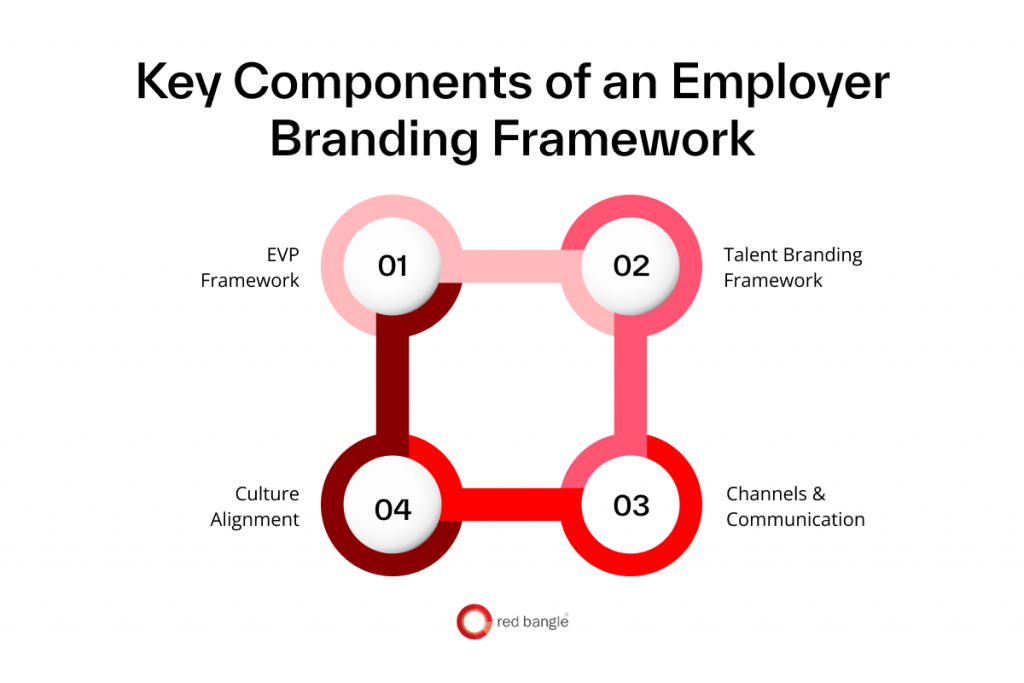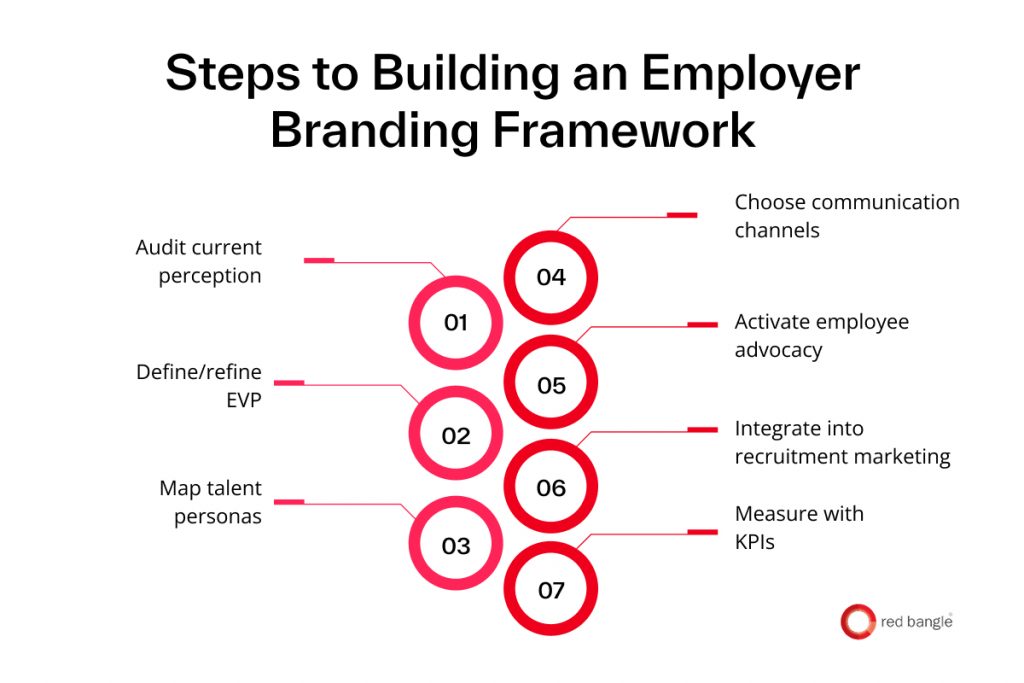Employer Branding Framework Explained: EVP, Strategy & Process
Build a talent brand that lasts. This guide breaks down the complete employer branding framework, EVP design, culture alignment, communication strategy, and KPIs, so you can attract, engage, and retain top talent with consistency, authenticity, and measurable ROI.

Introduction
When you think about the world’s most admired employers: Google, Salesforce, or Unilever, it isn’t just their products or salaries that attract people. It’s the story they tell as an employer.
Their employees become advocates, their culture is visible even to outsiders, and their hiring pipelines never run dry. That doesn’t happen by accident. It happens because they follow a structured employer branding framework.
Now contrast that with companies that rely on one-off recruitment campaigns. They post flashy job ads, maybe run a few social media promotions, and hope for the best. The result? Inconsistent messaging, poor candidate experiences, and higher attrition.
Candidates today don’t just want a job; they want to believe in the workplace they’re joining. And without a framework, businesses struggle to prove that belief.
In 2025, this gap is wider than ever. Hybrid work, AI-driven hiring, and Gen Z expectations around diversity, purpose, and transparency mean that employer branding has moved from “nice-to-have” to mission-critical. Glassdoor reviews, LinkedIn campaigns, and even employee TikToks shape how talent perceives you long before an interview happens.
That’s why building an employer branding framework isn’t just HR’s responsibility; it’s a cross-functional strategy that connects culture, communication, and measurable outcomes.
In this guide, we’ll show you what a framework looks like, why it matters, the components you need, and how to build one step by step with practical examples, KPIs, and a ready-to-use template.
What is an Employer Branding Framework?
An employer branding framework is a structured model that defines how a company attracts, engages, and retains talent. It aligns the employer value proposition (EVP) with culture, communication channels, and recruitment processes.
The framework codifies brand promises into clear messages supported by authentic employee stories and measurable outcomes. It includes steps to define EVP, activate talent branding, and track employer branding KPIs.
The model ensures consistency, credibility, and ROI by linking brand activities to hiring success, retention, and advocacy. A practical framework template helps HR leaders implement strategy with clarity and scale.
Think of it as the difference between running scattered hiring campaigns and having a repeatable system. A framework codifies your brand promise into clear messages, supported by employee stories and measurable outcomes. It guides HR, leadership, and even employees on how to communicate the company’s values in a way that feels credible and consistent.
Why Your Business Needs an Employer Branding Framework
Hiring has never been more competitive. Without a clear framework, companies often fall into a cycle of inconsistent messaging, poor candidate experiences, and higher attrition. Career sites promise one thing, employee reviews say another, and the gap leaves both candidates and employees disillusioned.
A well-structured employer branding framework changes that dynamic. It creates consistency, strengthens culture alignment, and connects branding efforts directly to measurable business outcomes.
Benefits of a Strong Employer Branding Framework
- Attract better talent: A clear employer value proposition (EVP) backed by proof points ensures job seekers understand what sets your workplace apart. LinkedIn research shows strong employer brands generate 50% more qualified applicants and reduce cost-per-hire by nearly 50%.
- Reduce turnover: When promises align with reality, employees stay longer. LinkedIn reports that companies with strong employer brands see turnover drop by up to 28%.
- Improve efficiency and cost savings: A trusted employer brand reduces dependence on costly recruitment marketing campaigns, external recruiters, or inflated compensation offers.
- Strengthen reputation: Consistent messaging across channels builds long-term credibility that extends beyond hiring, influencing customers, investors, and even media perception.
When you compare the two scenarios, the difference is clear:
Without a framework: scattered efforts, rising recruitment costs, mismatched expectations.
With a framework: consistency, stronger pipelines, lower attrition, and measurable ROI.
An employer branding framework doesn’t just help HR fill roles faster; it transforms your organization into an employer of choice. That credibility pays off not just in talent acquisition, but in retention, productivity, and overall business growth.
Key Components of an Employer Branding Framework

A strong employer branding framework is more than a collection of campaigns; it’s a structured system that ensures every message about your company is consistent, authentic, and measurable.
Four components make up the foundation: EVP, talent branding, communication channels, and culture alignment.
1. Employer Value Proposition (EVP) Framework
Your EVP is the cornerstone of employer branding. It defines what your company offers employees in return for their skills, time, and loyalty. Without it, messaging feels scattered, and candidates struggle to see why they should choose you.
A simple EVP framework is built through:
- Research: Gather insights from employee surveys, interviews, and market data.
- Drafting: Convert insights into clear themes like career growth, flexibility, or purpose.
- Validation: Test the draft with employees to check if it feels authentic.
- Rollout: Share across job descriptions, career pages, and internal communications.
For example, Infosys collaborated with Red Bangle to bring their EVP to life through the Infosys EB Leadership Series. By combining leadership stories and authentic narratives, they showcased career growth and culture as a core EVP pillar. You can explore the campaign here.
When done right, EVP becomes a guiding light for all branding efforts.
2. Talent Branding Framework
While EVP is the internal promise, talent branding is how you communicate it externally. It’s what candidates see before they even apply, on your social media, job ads, or company reviews.
A practical talent branding framework should:
- Use employee stories to bring the EVP to life.
- Tailor messaging for different talent segments (e.g., engineers, sales teams, graduates).
- Maintain consistency across platforms so the message doesn’t change depending on the channel.
Talent branding is most effective when EVP is amplified through campaigns that resonate emotionally. A strong example is the Treebo “Hotel Superhero” campaign, crafted by Red Bangle. Instead of focusing only on roles or benefits, the campaign highlighted frontline employees as heroes of hospitality, showcasing their dedication and everyday impact on customer experience.
This approach shows how talent branding can do more than advertise jobs; it can transform employees into authentic ambassadors of culture.
3. Channels and Communication
Consistency is everything when it comes to communication. An employer brand needs to be visible both inside and outside the company.
- Internal channels: newsletters, team meetings, employee portals.
- External channels: job boards, career websites, LinkedIn, review sites.
The key is balance. For example, a clear careers page (owned channel) supported by positive employee reviews (earned channel) makes your message more trustworthy.
4. Culture Alignment
No framework works without alignment between brand promises and workplace reality. If your career page promotes work-life balance but employees experience burnout, candidates will notice the disconnect.
Culture alignment means ensuring your internal experience reflects external messaging. You can achieve this by:
- Reinforcing values through policies and recognition programs.
- Encouraging employees to share genuine stories.
- Regularly reviewing feedback from employee surveys or exit interviews to spot gaps.
A culture-first approach works only when it feels authentic. That’s why companies today are moving beyond polished career pages and instead giving people an unfiltered view of daily life at work.
The Life at Infosys series, produced by Red Bangle, is a great example of this shift. Rather than relying on scripted statements, the series captured employee perspectives, team interactions, and the small but powerful cultural moments that define belonging.
This approach built trust with candidates by showing the culture as it really is, not as a marketing slogan.
How to Build an Employer Branding Framework (Step-by-Step)

A well-structured employer branding framework works like a roadmap: it starts with understanding where you stand, defines what you stand for, and ends with measurable results.
Here’s a practical, step-by-step process you can follow.
1. Audit Current Perception
You can’t fix what you don’t measure. Start by understanding your reputation as an employer.
How to do it:
- Collect anonymous employee feedback through surveys or pulse checks.
- Review external platforms like Glassdoor, AmbitionBox, or Indeed to see what candidates are saying.
- Talk to recent hires about their first impressions versus actual experience.
Once you know where you stand, you’ll see exactly which areas of your brand need strengthening.
2. Define or Refine Your EVP
Your Employer Value Proposition (EVP) is the promise you make to employees. Without it, your messaging will feel scattered.
How to do it:
- Gather insights: Ask employees why they stay, and ask candidates why they joined.
- Identify common themes: For example, growth opportunities, meaningful work, or flexible policies.
- Turn themes into statements: “We help employees grow faster by providing mentorship and structured career paths.”
- Test it with employees: Ensure it feels authentic, not aspirational fluff.
A clear EVP becomes the foundation of your framework; it tells people why they should choose you and why they should stay.
3. Map Talent Personas
Different roles value different things. Understanding your audience helps you personalize your message.
How to do it:
- List out key roles you want to hire or retain.
- Build a persona for each: job role, career motivators, preferred communication channels, and common concerns.
- Align EVP to these personas. Example: if flexibility is part of your EVP, highlight remote/hybrid work for digital roles, but career progression for leadership roles.
By mapping personas, you ensure your messaging resonates with the right people instead of trying to appeal to everyone.
4. Choose Communication Channels
The best EVP won’t matter if no one hears it. Choosing the right channels is critical.
How to do it:
- For internal communication: Use Slack groups, newsletters, or town halls.
- For external branding: Optimize your careers page, update LinkedIn regularly, and monitor employee review sites.
- Balance owned channels (career site, blog) with earned channels (employee advocacy, reviews) to build credibility.
Picking the right mix of channels ensures your employer brand reaches both your current employees and future candidates effectively.
5. Activate Employee Advocacy
Employees are the most trusted voice of your employer brand. Candidates trust employee stories far more than corporate messaging.
How to do it:
- Identify employees willing to act as ambassadors.
- Encourage them to share their stories on LinkedIn, videos, or podcasts.
- Provide guidelines and assets (templates, brand hashtags), but keep it authentic. Forced stories sound fake.
When employees become advocates, your employer brand feels more real and relatable, turning culture into your strongest recruitment tool.
6. Integrate with Recruitment Marketing
An employer brand is only powerful if it supports hiring outcomes.
How to do it:
- Align EVP with job descriptions so candidates immediately see the value.
- Include testimonials and EVP themes in your interview process.
- Train hiring managers to communicate EVP consistently.
- Use branded nurture emails to keep candidates engaged during the process.
Integration makes sure your brand isn’t just a marketing exercise; it actively improves the hiring journey.
7. Measure with Employer Branding KPIs
You can’t prove the value of your framework without measurement.
How to do it:
- Track awareness metrics: career site traffic, branded search volume.
- Track engagement metrics: application completion rate, employee referral rate.
- Track conversion metrics: offer acceptance, time-to-fill.
- Track retention metrics: eNPS (employee net promoter score), attrition rate.
Measuring KPIs shows whether your framework is delivering results and gives you the insights to continuously improve.
Also read → Corporate Explainer Videos: A Complete Guide for Businesses in 2025
Ready-to-Use Employer Branding Framework Template
A framework is only valuable when it can be applied in real-world situations. To help you put structure into action, here’s a simple, ready-to-use employer branding framework template.
You can adapt this table for your organization, whether you’re a growing startup or a large enterprise.
| EVP Theme | Target Audience | Key Messages | Channels | Owner | KPIs |
| Career Growth Opportunities | Young professionals, interns | “We reward effort with recognition and incentives” | LinkedIn, Career site, Onboarding kit | HR + Hiring Managers | Retention rate, promotion timelines |
| Flexibility & Wellbeing | Remote/hybrid employees | “Your work adapts to your lifestyle” | Slack, Newsletters, Employee blogs | HR + Internal Comms | eNPS, Glassdoor reviews, absenteeism |
| Purpose & Impact | Mid-level professionals | “Your work creates meaningful change” | Employer videos, Town halls, Social | Leadership + Comms Team | Candidate survey, offer acceptance rate |
| Rewards & Recognition | Sales & performance-driven | “We reward effort with recognition and incentives” | Job descriptions, Referral programs | HR + Team Leaders | Referral rate, offer acceptance, attrition |
| Culture & Inclusion | All employees & candidates | “Diverse, inclusive, and collaborative workplace” | Social media, Careers site, Ambassadors | DEI Committee + HR | Diversity metrics, engagement surveys |
How to Use This Template:
- Identify your EVP pillars.
- Define which talent groups or personas each pillar speaks to.
- Draft clear key messages that employees and candidates can understand.
- Match each message to the right internal and external communication channels.
- Assign owners (HR, leadership, managers, or comms teams).
- Set measurable KPIs to track performance and prove ROI.
With this template, you move from abstract ideas to a structured, measurable strategy. It keeps your employer branding framework consistent, scalable, and aligned with both employee experience and business goals.
Employer Branding KPIs Every HR Should Track
Building an employer branding framework is only half the work. The other half lies in proving its impact. That’s where employer branding KPIs come in. They turn abstract goals like “better reputation” into measurable outcomes you can track, report, and improve.
The Four KPI Pillars
1. Awareness — Are people noticing your brand?
Metrics here focus on visibility in the talent market.
- Growth in branded search volume
- Social media reach and impressions
- Mentions on employer review platforms
2. Engagement — Are they connecting with your message?
Engagement metrics show whether potential candidates are interested.
- Career site click-through rates
- Number of referral applications
- Interaction with employer-led events or content
3. Conversion — Are branding efforts driving hires?
Conversion KPIs link brand visibility to recruitment results.
- Application completion rate
- Offer acceptance rate
- Quality of hire scores
4. Retention — Are employees staying and advocating?
Retention KPIs measure whether your employer’s promise matches reality.
- Employee Net Promoter Score (eNPS)
- Attrition or turnover rate
- Internal promotions and referrals
The ultimate KPI is ROI. Strong employer branding saves money by reducing time-to-fill and cutting reliance on expensive recruitment campaigns. A simple formula can help you calculate it:
Employer Branding ROI = (Benefits – Costs) ÷ Costs x 100
For example, if reducing attrition saves your business $200,000 while branding activities cost $50,000, your ROI is 300%. [(200,000-50000) ÷ 50000 x 100]
KPIs make employer branding a business strategy, not just an HR initiative. They give leaders the data they need to justify investment, show progress, and refine strategy over time. Without them, you’re left guessing. With them, you can demonstrate that employer branding directly drives talent attraction, retention, and long-term growth.
Also read → What’s the next chapter for Employer Branding?
Employer branding is no longer just an HR initiative; it’s a business-critical strategy. A well-structured employer branding framework gives you the clarity to define your EVP, align culture with reality, activate the right communication channels, and measure success with meaningful KPIs. The payoff is clear: stronger talent pipelines, higher retention, and a reputation that makes people want to work with you and stay with you.
The real question isn’t if you need an employer branding framework, but how quickly you can implement one. The sooner you start, the sooner you’ll see the benefits, from reduced hiring costs to employees proudly advocating for your brand.
Over the years, Red Bangle has worked with leading brands like Infosys, Treebo, and Darwinbox to craft employer branding stories that attract, engage, and retain top talent. Whether it’s through leadership series, life-at-work videos, or innovative AI-led campaigns, we help organizations turn frameworks into impact. Let’s talk about how we can help you bring your employer branding framework to life.



